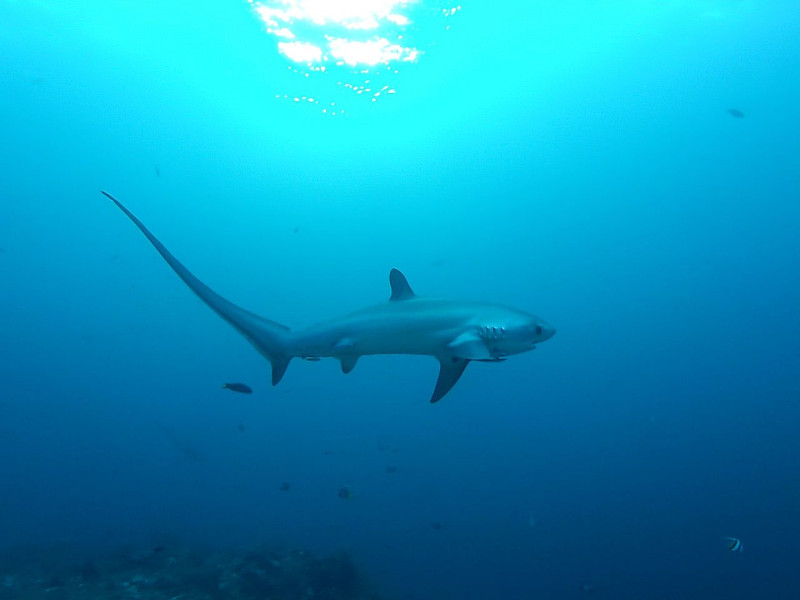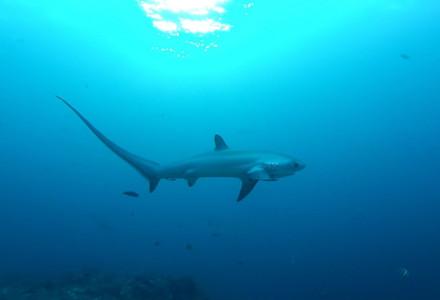
Photographer: Thomas Alexander
CC License: https://bit.ly/2V11Sir
Thresher Shark Facts
- The amazing Thresher Shark has a distinctly unique physical appearance that makes it easily recognizable. This holds true because the caudal fin grows to lengths proportionately far greater than other species of shark. In fact, it often attains virtually the same length as the body itself.
- Marine biologists suspect the possibility of the existence of a fourth species of Thresher Shark. Yet they remain uncertain, due to a lack of sufficient evidence. So far only one specimen has been discovered, thus scientists cannot officially confirm the existence of a fourth species.
- As members of the Lamniforme order, its body temperature remains higher than the water around it. This separates the creature from the great majority of other sharks. Finally, the three species in this genus include the Pelagic Thresher, the Bigeye Thresher, and the Common Thresher.
- Most notably, the IUCN currently lists all three as Vulnerable.
Related Articles
Goblin Shark Bull Shark Porbeagle
Photographer: Rafn Ingi Finnsson
CC License: https://bit.ly/3ypFSwt
Thresher Shark Physical Description
While the three known distinct species of Thresher Shark vary slightly in appearance, the general appearance remains the same.
The different species range in maximum length from 10 ft (3 m) to 20 ft (6.1 m). Maximum weights for the different species vary quite significantly, with the largest reaching 1,100 lb (500 kg).
Color also varies and includes gray, brown, blue, and even purplish. While the caudal fin grows large, the head remains relatively short, and the nose presents as somewhat cone-shaped.
Meanwhile, both the mouth and teeth remain rather small. Yet the oversized caudal fin ranks as the most noteworthy physical characteristic of the species.
- Kingdom: Animalia
- Phylum: Chordata
- Class: Chondrichthyes
- Order: Lamniformes
- Family: Alopiidae
- Genus: Alopias
Photographer: Klaus Stiefel
CC License: https://bit.ly/3l5s06r
Thresher Shark Distribution, Habitat, and Ecology
Most notably, the Thresher Shark inhabits all temperate and tropical oceans. Yet within that range, individuals generally only inhabit a specific portion of the ocean.
Only occasionally will it venture into shallow waters near shore, usually in search of prey. That’s because the animal generally inhabits the pelagic zone of its area of ocean. Regions far from shore, and extending no deeper than 1,600 ft (500 m) comprise its typical habitat.
This species also primarily preys on such creatures as bluefish, squid, mackerel, and cuttlefish. Yet individuals will occasionally consume crustaceans and even seabirds. These often employ their enormous caudal fin to stun the prey by slapping the surface of the water.
The fish lives a primarily solitary life, yet will sometimes form small groups for hunting, however.
Species Sharing Its Range
Atlantic Wolffish Maui Dolphin Dugong
Check out our other articles on Shark Finning Whims, Neptune’s Grotto, African Penguin, Seychelles Sheath-Tailed Bat, Smooth Purple Coneflower, Lau Banded Iguana

